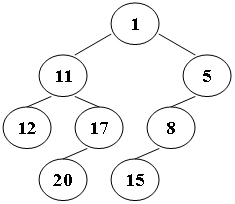Suppose that all the keys in a binary tree are distinct positive integers. A unique binary tree can be determined by a given pair of postorder and inorder traversal sequences. And it is a simple standard routine to print the numbers in level-order. However, if you think the problem is too simple, then you are too naive. This time you are supposed to print the numbers in “zigzagging order” – that is, starting from the root, print the numbers level-by-level, alternating between left to right and right to left. For example, for the following tree you must output: 1 11 5 8 17 12 20 15.

Input Specification:
Each input file contains one test case. For each case, the first line gives a positive integer N (≤30), the total number of nodes in the binary tree. The second line gives the inorder sequence and the third line gives the postorder sequence. All the numbers in a line are separated by a space.
Output Specification:
For each test case, print the zigzagging sequence of the tree in a line. All the numbers in a line must be separated by exactly one space, and there must be no extra space at the end of the line.
本菜鸡只会用建树的方法做:建树->求每一层的节点顺序->分层从前往后或从后往前输出
#include<iostream>
#include<vector>
#include<queue>
using namespace std;
typedef struct node {
int data, level;
node *l, *r;
}*tree;
int n, post[40], in[40], depth = 0;
vector<int>res[40];
tree createT(int inS, int inE, int postS, int postE) {
if (inS > inE)return NULL;
tree t = new node();
t->data = post[postE];
int i;
for (i = inS; i <= inE; i++) {
if (in[i] == post[postE])break;
}
t->l = createT(inS, i - 1, postS, postS + i - 1 - inS);
t->r = createT(i + 1, inE, postE + i - inE, postE - 1);
return t;
}
void bfs(tree root) {
queue<tree>q;
q.push(root);
root->level = 1;
while (!q.empty()) {
auto temp = q.front();
if (temp->level > depth) {
depth = temp->level;
}
q.pop();
res[temp->level].push_back(temp->data);
if (temp->l != NULL) {
temp->l->level = temp->level + 1;
q.push(temp->l);
}
if (temp->r != NULL) {
temp->r->level = temp->level + 1;
q.push(temp->r);
}
}
}
int main() {
cin >> n;
for (int i = 0; i < n; i++)cin >> in[i];
for (int i = 0; i < n; i++)cin >> post[i];
tree t = createT(0, n - 1, 0, n - 1);
bfs(t);
cout << res[1][0];
for (int i = 2; i <= depth; i++) {
if (i % 2 == 0) {
for (int j = 0; j < res[i].size(); j++) {
cout << " " << res[i][j];
}
}
else if (i % 2 == 1) {
for (int j = res[i].size() - 1; j >= 0; j--) {
cout << " " << res[i][j];
}
}
}
return 0;
}





 本文介绍了一种解决二叉树锯齿形层次遍历问题的方法,通过构建二叉树并进行广度优先搜索,实现从根节点开始,按层次交替从左到右和从右到左打印节点值。输入包括节点总数、中序和后序遍历序列,输出为锯齿形层次遍历序列。
本文介绍了一种解决二叉树锯齿形层次遍历问题的方法,通过构建二叉树并进行广度优先搜索,实现从根节点开始,按层次交替从左到右和从右到左打印节点值。输入包括节点总数、中序和后序遍历序列,输出为锯齿形层次遍历序列。
















 1963
1963

 被折叠的 条评论
为什么被折叠?
被折叠的 条评论
为什么被折叠?








